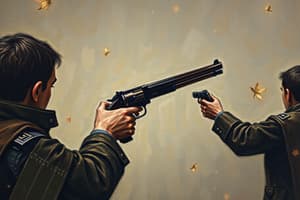Podcast
Questions and Answers
According to a 2023 Pew Research Center survey, what percentage of U.S. adults report living in a household with a gun?
According to a 2023 Pew Research Center survey, what percentage of U.S. adults report living in a household with a gun?
About 40% of U.S. adults report living in a household with a gun.
What is the primary reason given by gun owners for owning a firearm, according to the Pew Research Center survey?
What is the primary reason given by gun owners for owning a firearm, according to the Pew Research Center survey?
The primary reason given by gun owners for owning a firearm is personal protection.
Compare the percentage of Republicans and Democrats who say they personally own a gun.
Compare the percentage of Republicans and Democrats who say they personally own a gun.
45% of Republicans and GOP-leaning independents say they personally own a gun, compared with 20% of Democrats and Democratic leaners.
How does the percentage of gun owners vary based on community type?
How does the percentage of gun owners vary based on community type?
What percentage of gun owners say they enjoy owning a gun, and what percentage of nonowners living in a gun household say they enjoy having a gun in the home?
What percentage of gun owners say they enjoy owning a gun, and what percentage of nonowners living in a gun household say they enjoy having a gun in the home?
How do feelings about gun ownership differ between Republican and Democratic owners?
How do feelings about gun ownership differ between Republican and Democratic owners?
What percentage of Americans favor stricter gun laws based on the survey mentioned?
What percentage of Americans favor stricter gun laws based on the survey mentioned?
What is the public opinion regarding the importance of protecting gun rights versus controlling gun ownership?
What is the public opinion regarding the importance of protecting gun rights versus controlling gun ownership?
How do views on gun ownership's impact on safety differ between Republicans and Democrats?
How do views on gun ownership's impact on safety differ between Republicans and Democrats?
What percentage of public K-12 teachers are at least somewhat worried about school shootings?
What percentage of public K-12 teachers are at least somewhat worried about school shootings?
Flashcards
Second Amendment
Second Amendment
The part of the U.S. Constitution that guarantees the right to bear arms.
Gun ownership statistics
Gun ownership statistics
About 32% of U.S. adults personally own a gun as of June 2023.
Reasons for gun ownership
Reasons for gun ownership
72% of gun owners cite personal protection as a major reason for owning a firearm.
Attitudes of gun owners vs. nonowners
Attitudes of gun owners vs. nonowners
Signup and view all the flashcards
Demographics of gun ownership
Demographics of gun ownership
Signup and view all the flashcards
Political Views on Gun Ownership
Political Views on Gun Ownership
Signup and view all the flashcards
Non-Gun Owners' Future Attitudes
Non-Gun Owners' Future Attitudes
Signup and view all the flashcards
Perception of Legal Gun Access
Perception of Legal Gun Access
Signup and view all the flashcards
Support for Stricter Gun Laws
Support for Stricter Gun Laws
Signup and view all the flashcards
Gun Ownership and Safety Perception
Gun Ownership and Safety Perception
Signup and view all the flashcards
Study Notes
American Gun Ownership and Attitudes
- Gun Ownership Prevalence: Approximately one-third of US adults own firearms. Four-in-ten Americans live in households with guns. This figure remained stable between 2021 and 2023. Significant variation exists based on factors like political affiliation, gender, community type (rural vs. urban), and race/ethnicity. Rural areas show significantly higher gun ownership rates (47%) compared to urban (20%) and suburban (30%) areas.
Reasons for Gun Ownership
- Self-Protection: Personal protection is the primary reason cited by gun owners (72%). This aligns with survey results from 2017, where 67% of gun owners gave this rationale. Hunting (32%), sport shooting (30%), collections (15%), and employment (7%) are other reasons.
Gun Owners vs. Non-Owners
- Enjoyment and Safety: Gun owners express far greater enjoyment of having a gun (71%) and feel safer due to gun ownership (81%) than non-owners living in the same household (31% and 57%, respectively). Non-owners are more likely to be concerned about firearm possession (27% vs. 12%). Political affiliation influences even those who own guns; Republican gun owners more often report safety/enjoyment, while Democratic owners are more likely to express concern.
Future Gun Ownership
- Non-owners divided: Half of non-gun owners (52%) say they could never own a firearm; nearly half (47%) can imagine doing so. Variation exists based on political affiliation, gender, and race/ethnicity, where non-owners have more propensity to own firearms aligned with Republican affiliation, male gender, and Black race.
Legal Gun Acquisition
- Ease of Access: A majority of Americans (61%) view gun acquisition as too easy in the US, with non-gun owners expressing a greater concern (73%) compared to gun owners (38%). Urban and suburban residents are also more likely to think legal access is too easy (72% and 63%), while rural residents are more split. Political affiliation sharply influences opinions, with overwhelming (86%) support from Democrats on making gun ownership too easy compared to Republicans (34%).
Gun Laws
- Stricter Gun Laws: Most Americans (61%) favor stricter gun laws while 15% think laws should be less strict and 26% think the current status is adequate. There's bipartisan agreement on measures like preventing mentally ill individuals from acquiring firearms (88% of Republicans, 89% of Democrats support) and raising the minimum gun purchasing age to 21 (69% of Republicans, 90% of Democrats). However, substantial party divisions emerge on other proposals, such as banning assault weapons and high-capacity magazines (85% of Democrats favor, 57% and 54% of Republicans oppose) and the ability for teachers to carry guns in schools (74% of Republicans, 27% of Democrats support). Concealed carry without permits is opposed by a majority of both parties (60% of Republicans, 91% of Democrats).
Gun Rights vs. Gun Control Debate
- Prioritized value: A majority (51%) prioritize protection of gun rights, while another 48% prioritize gun control. Republicans (83%) more often prioritize gun rights compared to Democrats (79%). The public prioritization in 2024 shifted from 2022, when it was the opposite (47% to 52%).
Gun Ownership's Safety Impacts
- Safety Perception: Americans are slightly more inclined to view gun ownership as increasing safety (52%) than reducing it (47%). Republicans (81%) overwhelmingly view gun ownership positively, while Democrats (74%) are more likely to identify negative impacts. Rural residents show greater support for gun ownership bolstering safety (64%) than urban residents (57%), with suburban views being near a tie between increased and decreased safety.
Gun Increase Impact
- Societal Impact: A majority of Americans (54%) believe an increase in gun availability is bad for society, compared with 21% who think it is good, and a quarter who hold a neutral stance.
Concerns about Gun Violence
- Gun Violence Concern: Fifty percent of Americans view gun violence as a major problem (down from 60% in 2023). The perceived severity of gun violence fluctuates, at times remaining roughly par with prior years.
Teacher and Parent Concerns
- School Shooting Worries: Public K-12 teachers (59%) exhibit concern about school shootings, with 18% feeling significantly worried. K-12 parents (32% very/extremely worried, 37% somewhat worried) also share this concern.
Studying That Suits You
Use AI to generate personalized quizzes and flashcards to suit your learning preferences.




